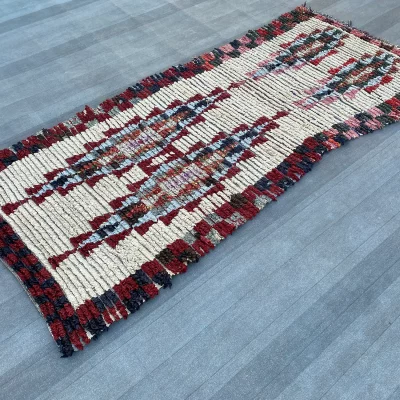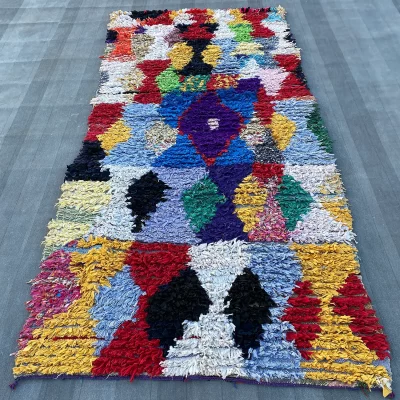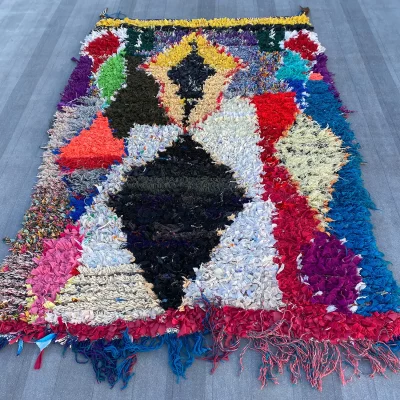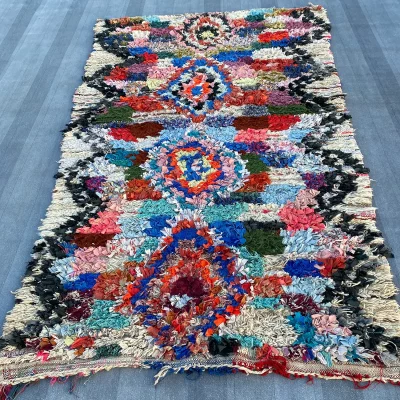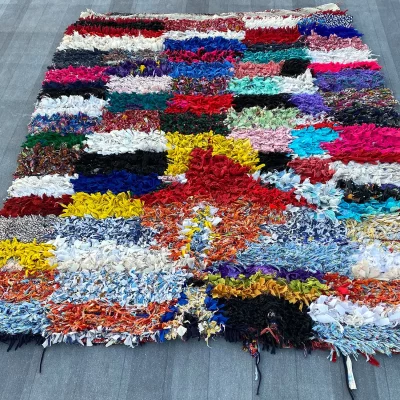* Free Shipping On All Orders.
5 / 5
VIEW
- 2
- 3
- 4
Frequently Asked Questions
What is a Boucherouite rug?
A Boucherouite rug, is a type of handmade rug that originates from Morocco. Unlike traditional rugs made from wool or cotton, Boucherouite rugs are crafted using recycled materials such as fabric scraps, old clothing, and various textile remnants. These materials are repurposed and woven together to create vibrant and colorful rugs with unique patterns and textures. Boucherouite rugs showcase the creativity and resourcefulness of Moroccan artisans and are often considered eco-friendly and sustainable due to their use of recycled materials. They add a bohemian and artistic touch to any space.
How to make a Boucherouite rug?
Making a Boucherouite rug is a labor-intensive process that requires creativity and skill. Here are the general steps involved in making a Boucherouite rug:
- Collect Materials: Gather a variety of fabric scraps, old clothing, and textile remnants in different colors and patterns. These will be used as the raw materials for your rug.
- Prepare the Strips: Cut the collected fabrics into long strips of equal width. The width can vary depending on your preference, but typically ranges from 1 to 3 inches.
- Design and Planning: Decide on the size and design of your rug. You can create a rough sketch or plan to guide you during the weaving process.
- Warp the Loom: Set up a loom or a frame to provide the structure for weaving. Secure the vertical threads, known as the warp, tightly across the loom to create the foundation.
- Weaving: Begin weaving the fabric strips horizontally through the warp threads. Use a basic over-under technique, alternating the strips to create a tight and sturdy weave.
- Color and Pattern: Arrange the fabric strips in different colors and patterns to create the desired design. You can experiment with different combinations and arrangements to achieve the desired aesthetic.
- Finishing: Continue weaving until you reach the desired size of the rug. Trim any excess fabric and secure the ends to prevent unraveling.
- Final Touches: Once the weaving is complete, remove the rug from the loom or frame. Give it a gentle shake to remove any loose threads or debris.
- Cleaning and Maintenance: Clean the rug by gently shaking or vacuuming it to remove dust and dirt. Avoid washing the rug unless necessary, as it may damage the woven fabric.
Finally it’s worth noting that making a Boucherouite rug requires time, patience, and weaving skills.
How to clean a boucherouite rug?
Cleaning a Boucherouite rug requires gentle care to preserve its colors and integrity. Here are some steps to clean your Boucherouite rug:
- Shake or Vacuum: Start by shaking the rug outdoors to remove loose dirt and debris. Alternatively, you can use a vacuum cleaner with a brush attachment to gently suction away dust and dirt. Be sure to use low suction and avoid forcefully pulling on the rug.
- Spot Cleaning: If you notice any stains or spills on the rug, address them promptly. Blot the affected area with a clean, damp cloth or sponge using a mild detergent mixed with water. Avoid rubbing or scrubbing vigorously, as it may damage the fibers or cause color bleeding.
- Air Dry: After spot cleaning, allow the rug to air dry completely in a well-ventilated area. Avoid direct sunlight or heat sources, as they can fade or distort the colors. Flip the rug occasionally during the drying process to ensure both sides are exposed to air.
- Professional Cleaning: For deeper cleaning or extensive stains, it is advisable to seek professional rug cleaning services. They have the expertise and equipment to clean and maintain Boucherouite rugs without causing damage.
- Regular Maintenance: To prolong the life of your Boucherouite rug, regularly rotate it to ensure even wear. Avoid placing heavy furniture directly on the rug, as it can cause compression or distortion. Additionally, consider using rug pads underneath to provide cushioning and prevent slipping.
